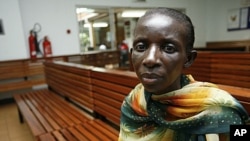After a wildly successful campaign against AIDS in the 1990s, Uganda is now the only country in East Africa where the AIDS rate is actually rising. Some people attribute this to a Bush-era abstinence-only approach to AIDS prevention, a policy at odds with patterns of sexual behavior in Uganda.
Uganda was once a shining example of successful AIDS prevention, when, in the 1990s and early 2000s, it managed to slash its infection rate from around 15 percent to 6 percent. But for the past five years, infections have once again been on the rise, leading many people to question what went wrong.
Exact statistics on mounting infection rates are not due to be published until next year. But on December 1, World AIDS Day, the Ugandan government launched a new HIV Prevention Strategy to address the worrying trend.
Changing sexual behaviors
Zainab Akol of the Ministry of Health says that one of the reasons for the rise is complacency, but she admits that attempts to change people’s sexual behavior were not very successful. She says that in the future, Uganda intends to focus more on medical and educational methods to prevent transmission and treat those who are already infected.
“We are talking about scaling up anti-retroviral treatment, we are talking about male circumcision, we are talking about scaling up HIV counseling and testing. We now understand that it’s very difficult to deal with sexual behavior," Akol explained. "We hadn’t understood. We thought people would just hear the threat and develop fear, but we now see that fear doesn’t work all the time.”
Abstinence-only backfires
Many experts blame the rising infection rate on a communication strategy that promoted abstinence only until marriage, without encouraging the use of condoms. This was the message of the American-funded PEPFAR, which stands for President’s Emergency Plan for AIDS Relief.
Established in 2003 under former U.S. President George W. Bush, PEPFAR has provided hundreds of millions of dollars in funding for Uganda’s AIDS programs. Its focus on abstinence was eagerly adopted here, where the message fit in well with a culture of conservative Christianity.
But now, with the rate of new HIV infections rising fastest among married couples, this strategy seems to have backfired. Asia Russell, of the advocacy organization Health GAP, says that PEPFAR’s approach has expanded in recent years to include encouraging condom use. But, she adds, the U.S. government still funds programs focusing on abstinence.
“About 46 percent of new infections in this country are between married, co-habitating people in stable relationships. And yet, if you drive around Kampala you see many billboards that communicate that marriage protects people. That’s false information," Russell said. "It’s wasteful, and it’s harmful. Meanwhile, we all know of facilities where people can’t get free condoms. We’re concerned that some of these messages still find their way into the community, and still receive investments from the U.S. government.”
Moralistic approach not a solution
Leonard Okello, of the International HIV/AIDS Alliance in Uganda, says the problem is that using moral values such as marriage to fight the spread of HIV has given married people a false sense of security. With Uganda’s widespread culture of marital infidelity, he says, abstaining can still put you at risk.
“If you adopt a more moralistic approach, you get these problems. I think we need to recognize that it is not just about morals. Even abstinence has its limitations, because not everybody is abstaining. They go to church, wed this one and only wife and one and only husband, and then lead a traditional polygamous life. It seems to be an acceptable norm,” Okello stated.
But, Okello explains, even being faithful is not always safe. He was married for eight years to a woman who was HIV positive, a situation, he says, that the abstinence-only message fails to address.
“My wife was HIV positive, and I was HIV negative. I was faithful to my wife. She got HIV infected earlier, but we didn’t know. By remaining faithful, I was actually at risk. So it doesn’t necessarily mean being faithful is safe," he noted. "Those are the realities we did not know then. When PEPFAR was pushing very much the abstinence agenda, we forgot that the epidemic was changing rapidly.”
AIDS activist Rukia Nansubuga, who is HIV positive herself, says that one of the main obstacles to controlling the virus among married couples is simple fear of disclosing your status to your spouse.
“When a woman comes out to be tested, she fears to disclose to her partner. Once the woman declares that 'I’m HIV positive,' then that’s the end of the marriage," Nansubuga said. "When I disclosed and my husband knew my status, he abandoned me. Now I’m a single mother living with HIV/AIDS, with seven children.”
More resources needed
Increasing medical interventions and treatments in Uganda just became more difficult, as the Global Fund to Fight AIDS, Tuberculosis and Malaria announced last month that no new funding would be available until 2014.
Russell says that in order to bring infection rates down, Uganda will have to commit more of its own resources to the struggle. She also hopes the current crisis will re-galvanize the country’s leadership, including President Yoweri Museveni, because over the past several years, she says, political will has begun to slip.
“One feature that distinguished the response in this country is Museveni and other high-profile leaders speaking in an extraordinarily committed way to the fight against HIV. That changed over the last few years. I think people noticed a silence, and noticed more stigmatizing language about people with HIV coming out of statehouse,” Russell noted.
Both Russell and Okello agree that with the treatments available and enough information, an HIV-free generation is within reach. But it remains to be seen whether Uganda can summon the political commitment and resources to make it happen.
Photo Gallery: World AIDS Day












